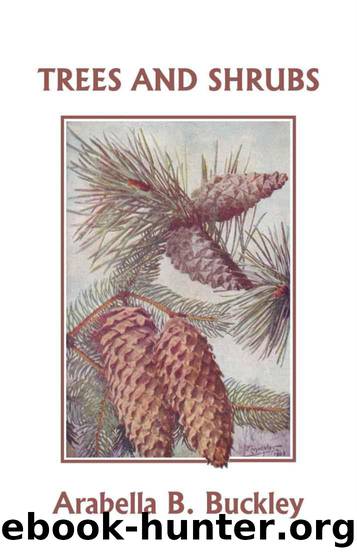Trees and Shrubs (Yesterdays Classics) by Buckley Arabella B

Author:Buckley, Arabella B. [Buckley, Arabella B.]
Language: eng
Format: epub
Tags: Nature
ISBN: 9781599152752
Publisher: Yesterdays Classics
Published: 2010-11-08T14:08:41.934000+00:00
CHAPTER VIII
Trees Which Bear Cones
PINES, firs, and larches grow in almost all parts of England. They are very interesting and useful trees. They all form their seeds in woody cones, and their leaves are very narrow or needle-shaped, quite unlike the leaves of most other trees.
A large part of the timber we use comes from pines and firs, grown in Norway and other countries. It is called pine-wood and deal. No doubt you have noticed the small round pieces called "knots" in deal, and have poked them out, leaving a hole. These are places where branches grew and broke off, and then the trunk closed round them; they are common in deal and pinewood. The sap in these trees is very resinous and they are tapped for turpentine. If you walk in a pine wood, or crush the leaves of a pine or fir, you will notice the strong scent of this resinous juice.
Every country child has picked up fir cones, and you may easily find three different kinds, those belonging to the Scotch pine, the Spruce fir, and the Larch. Of these three, only the Scotch pine is a native of Great Britain, the other two have been brought from abroad.
There were once dense forests of Scotch pine in England, but these have been cut down long ago, and the pine woods we have now, have grown up from the seeds of trees brought from the great forests in Scotland, Norway, and France. It is a tall tree with spreading branches and a trunk covered with a red or brown scaly bark. Perhaps you know it as Scotch fir, for people confuse these two names, and call the same tree "pine" or "fir," though you may know the difference if you look at the cones.
The dark-green leaves of the Scotch pine are very narrow, and about two inches long. They grow two together in a sheath of brown scales. Its cones have no stalks, and they bulge out at the bottom, and taper away to a blunt point at the upper end. They are made of a number of thick woody scales which look as if they were folded back at the top, making a solid thick knob with a brown scaly spot where the tip ends. These scales fit over each other so tightly that, before the cone is ripe, not even a drop of rain can get in, and they take two or three years to ripen. Sometimes they hang all the time on the tree. Sometimes they fall off earlier. As they ripen, the woody scales bend outwards and you can see two thin, transparent scales inside each, which look like the wings of a fly. They stand upright against the woody scale.
Slip a knife carefully down under these, right to the bottom and pull them out. You will find a seed at the end of each, if you have not broken the tender translucent membrane.
For these are winged seeds, which have no seed-box over them, but grow naked inside the woody scale.
Download
This site does not store any files on its server. We only index and link to content provided by other sites. Please contact the content providers to delete copyright contents if any and email us, we'll remove relevant links or contents immediately.
The Lonely City by Olivia Laing(4572)
Animal Frequency by Melissa Alvarez(4156)
All Creatures Great and Small by James Herriot(3989)
Walking by Henry David Thoreau(3685)
Exit West by Mohsin Hamid(3637)
Origin Story: A Big History of Everything by David Christian(3473)
COSMOS by Carl Sagan(3353)
How to Read Water: Clues and Patterns from Puddles to the Sea (Natural Navigation) by Tristan Gooley(3242)
Hedgerow by John Wright(3110)
How to Do Nothing by Jenny Odell(3103)
The Inner Life of Animals by Peter Wohlleben(3101)
How to Read Nature by Tristan Gooley(3083)
Project Animal Farm: An Accidental Journey into the Secret World of Farming and the Truth About Our Food by Sonia Faruqi(3019)
Origin Story by David Christian(2997)
Water by Ian Miller(2957)
A Forest Journey by John Perlin(2918)
The Plant Messiah by Carlos Magdalena(2751)
A Wilder Time by William E. Glassley(2693)
Forests: A Very Short Introduction by Jaboury Ghazoul(2672)
